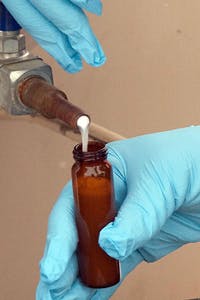By Patrick Crow, Washington Correspondent
Concerns about hydraulic fracturing (fracking) water are swirling on several fronts in Washington, but substantial changes are not in prospect.
The oil and gas industry has long used fracking to release hydrocarbons from dense geologic zones like tight sandstones and shales. Likewise, fracking has increased greatly with the shale drilling boom, which combine horizontal completions with massive fracturing jobs.
From the perspective of water, fracking poses some latent threats. Chemicals are mixed with the fracturing water, and in some instances, it has allegedly escaped to contaminate groundwater supplies. In some cases, the recovered water is treated at sewage plants. With the large amount of water needed for hydraulic fracturing, consumption also is rapidly becoming a larger issue, especially in the arid west.
Earlier this year, the American Water Works Association (AWWA) issued a white paper addressing concerns about the potential of hydraulic fracturing to impact surface water and groundwater supplies.
"Water utilities are increasingly faced with difficult questions about the potential for water contamination resulting from hydraulic fracturing,” it said. "While most industrial activity carries some environmental risk, AWWA's findings suggest that risks associated with fracking can be managed through prudent regulation and responsible industry practices.”
In Congress, a scattering of bills has been introduced to increase precautions in fracturing operations. No bills were passed last session, and they're equally unlikely to be approved this Congress, especially given the political chasm between the House and Senate.
On the administrative side of Washington, the Interior Department's Bureau of Land Management (BLM) is working on a rule covering fracturing on federal and Indian lands, but ultimately the key player in the policy debate will be the Environmental Protection Agency (EPA).
BLM said its draft rule would require operators to disclose the chemicals they use in fracturing activities on public lands, ensure well-bore integrity so that fluids used during fracturing operations cannot contaminate groundwater, and require that oil and gas operators have a water management plan for handling fluids that flow back to the surface.
Accordingly, BLM took a middle road to fracking oversight that irked both sides. Environmental groups said the disclosure and water monitoring requirements were inadequate to protect public health and the environment, and oil and gas associations said the rule should have deferred to state oversight of groundwater.
As an indication of the controversy, as BLM began the rulemaking, it received 177,000 public comments on what the guidance should cover. It is uncertain when a final rule will be promulgated.
EPA is conducting an extensive assessment of the environmental and health effects of fracking on drinking water resources. When that study is finished next year, it could lay the groundwork for further agency or legislative action.
Pro-oil industry congressmen expect as much. "EPA has long been searching for a problem to justify its ‘solution' of hydraulic fracturing regulations, which would deal a fatal blow to our dream of U.S. energy independence,” said Sen. James Inhofe (R-Okla.).
For the time being, anyway, the shale gas juggernaut will keep rolling.
The U.S. Energy Information Administration has predicted that U.S. natural gas production will jump from 23.0 trillion cubic feet in 2011 to 33.1 trillion cubic feet in 2040, a 44-percent gain. "Almost all of this increase is due to projected growth in shale gas production, which grows from 7.8 trillion cubic feet in 2011 to 16.7 trillion cubic feet in 2040,” it said.
In the field, the industry has begun to adapt to the pressures of both politics and economics.
Hydraulic fracturing is expensive, largely because of the costs involved in hauling millions of barrels of freshwater to well sites and later to disposal wells for underground injection.
Now some operators are treating flowback water from fracked wells just enough to enable its reuse. Before, they thought they only would receive acceptable results from freshwater and that it would be too expensive to treat flowback water.



